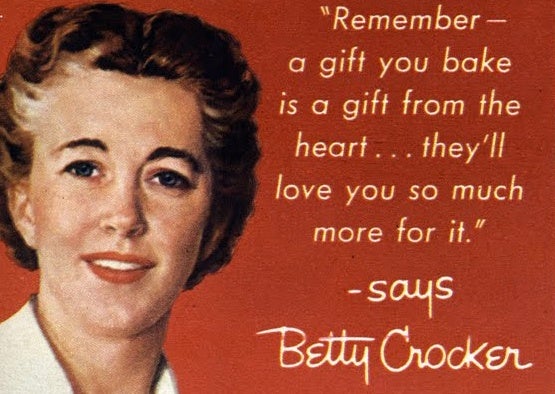At first, Betty Crocker was nothing but a signature. The woman who would become America’s most beloved baker sprang to life in the all-male advertising department of Washburn-Crosby, a Minneapolis flour company, in 1921. They needed a trustworthy spokeswoman to respond to inquiries about shrinking piecrusts and cracked cakes; no one would have had faith in baking tips signed by a businessman. “Betty” was chosen as a friendly first name, “Crocker” was the last name of a former company executive, and her autograph—studiously legible, with an emphatic horizontal slash that floated somewhere above the Ts—was a composite of handwriting samples collected from the women who worked at Washburn-Crosby (which would later become General Mills).
In 1924, Betty got a voice when Washburn-Crosby purchased a small Midwestern radio station as an advertising tool and introduced the “Betty Crocker Cooking School of the Air.” A home economist in the company’s Home Services Department played the first Betty Crocker, but soon Betty was everywhere, with different women reading the same script on stations all over the country. “Hello, everybody,” these Bettys would say at the beginning of each broadcast, before sharing recipes and kitchen tips.
A dozen years after the program’s debut, that cacophony of voices got a single face. In her first official portrait, Betty stares directly at the viewer, with arched eyebrows and pursed red lips, her finger waves wilted but her frilled white collar primly starched. The overall effect is slightly stern, more strict schoolmarm than indulgent housewife. The sketch captured what made Betty so popular: an air of expertise that could guide homemakers through the deprivations of the Great Depression and the patriotic sacrifices of World War II. By the end of the war, Betty was receiving nearly 4,000 letters a day from housewives seeking advice and inspiration.
And finally at the dawn of the television era, in 1950, “America’s First Lady of Food” became a three-dimensional woman, portrayed by actress Adelaide Hawley, who herself hated to cook, but had the looks and poise to bring Betty to life.
The invention of Betty Crocker was complete. The concept was so successful, as Susan Marks writes in Finding Betty Crocker: The Secret Life of America’s First Lady of Food, that some visitors to the Betty Crocker Kitchens in Minneapolis, who expected to find the icon herself at work, burst into tears upon discovering that Betty Crocker was a fiction.

What is most remarkable, however, is not that Betty Crocker was an invention, explains the culinary historian Laura Shapiro—many of the era’s cooking spokeswomen were fictional—but that, in first imagining Betty in the 1920s and ‘30s, Washburn-Crosby had created a confident, professional woman. The face of Gold Medal flour was not a smiling housewife. Betty had no impish children and no husband to welcome home with baked goods. In fact, she had no private life at all. She was introduced, in her television show, as an authority, seated behind a desk. In her gleaming white kitchens, she directed a crew of professional bakers.
Shapiro credits that vision to Marjorie Child Husted, a home economist who started at Washburn-Crosby in 1924, just as Betty took to the airwaves. Husted, who was a cooking instructor before taking over the company’s Home Service Department, saw Betty as “the home-economist-in-chief,” Shapiro writes. Husted encouraged the company to create foolproof recipes that would help every homemaker feel as knowledgeable as the kitchen maven. She wrote Betty Crocker’s scripts, occasionally served as her voice on the radio, and every night Husted—who was often confused with the Betty Crocker character she brought to life—took home a briefcase full of the letters that had been sent to the imaginary woman. Those letters from America’s housewives shaped Betty’s mission.
Today, Betty Crocker is a logo on a box of cake mix, but in Husted’s era, her job was far bigger than selling Gold Medal flour. “Women needed a champion,” Husted said. “Here were millions of them staying at home alone, doing a job with children, cooking, cleaning on minimal budgets—the whole depressing mess of it. They needed someone to remind them they had value.”







